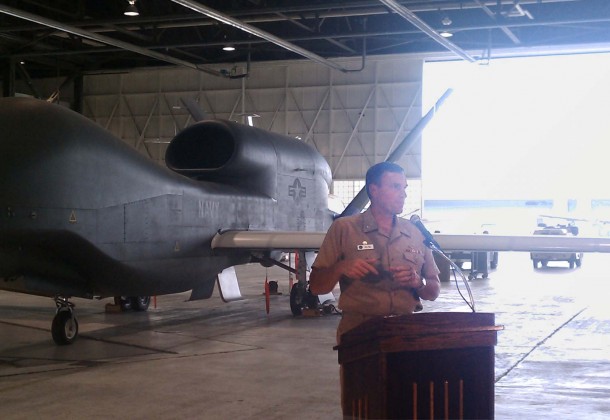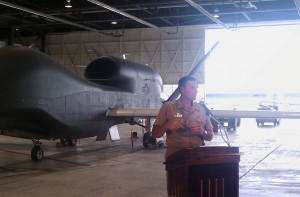Navy: Mechanical Failure Caused Global Hawk Crash

By Jay Friess
Editor
When pressed by reporters Tuesday, a Navy official would not say exactly what caused a Navy Global Hawk unmanned aircraft to crash on the Eastern Shore after leaving Naval Air Station Patuxent River June 11, but he was clear on one point.
Capt. James B. Hoke, program manager for the Navy’s Persistent Maritime Aircraft Systems Program Office at Pax River, reiterated that the crash was not a communications or operator failure.
“It was mechanical in nature,” Capt. Hoke said. He acknowledged that, like the Air Force, the Navy is having problems with the Block 10 version of Northrop Grumman’s Global Hawk aircraft. “We have reliability challenges with this block of aircraft.”
Further details of the crash are enclosed in an unreleased report, recently completed by the Navy’s accident review board. Capt. Hoke said the media would have to request the release of the report.
According to Capt. Hoke, three of the Global Hawks being used for the Navy’s Broad Area Maritime Surveillance Demonstrator (BAMS-D) program stay at Pax River, while a fourth is rotated out to the Persian Gulf to provide intelligence, surveillance and reconnaissance (ISR) to Naval forces there. Cruising at 60,000 feet for 24 hours at a time, Hoke said the aircraft provides the fleet with half of its ISR information in the Gulf. Operators use the plane to track the movement of cargo ships and employ its radar and camera to spot potential threats.
According to Capt. Hoke, the Navy’s new Triton aircraft, a modified Block 40 version of the Global Hawk, will provide more endurance, capability and reliability than the current demonstration aircraft.
“It is not the same as the Global Hawk by any stretch,” Capt. Hoke said.
The Triton will have a taller antenna dome and titanium trim to reduce wing and intake icing. The aircraft will also be equipped with a more sophisticated all-direction radar and a camera capable of transmitting full-motion video.
The wingspan of the Triton has been increased from 117 feet to 130 feet. The wings are stiffer and mounted higher. They are also equipped with one hard point on each wing for what Capt. Hoke called “future growth capability.”
“It wasn’t necessarily a weapons provision,” Capt. Hoke added, explaining that future sensor pods or other instruments could be attached to the mounting points. “There’s lots of things you can put on wings.”
The first test version of the Triton was introduced by Northrop Grumman in June, and Capt. Hoke said it will undergo flight envelope expansion testing in Palmdale, California before coming to Pax River for Navy testing in late spring or early summer of next year. The Navy hopes to begin testing the Triton in theater by 2015 and deploy it to the fleet by January 2016.
A total of 22 aircraft are slated to be produced for the initial rollout, giving the Navy four planes to put on each of five “orbits” around the world. Capt. Hoke said the program will likely produce 68 aircraft over the next three decades, but he is optimistic that the aircraft will last longer than the Navy’s projections.
“We think we’re going to get more life out of these then we’re planning,” Capt. Hoke said.
























